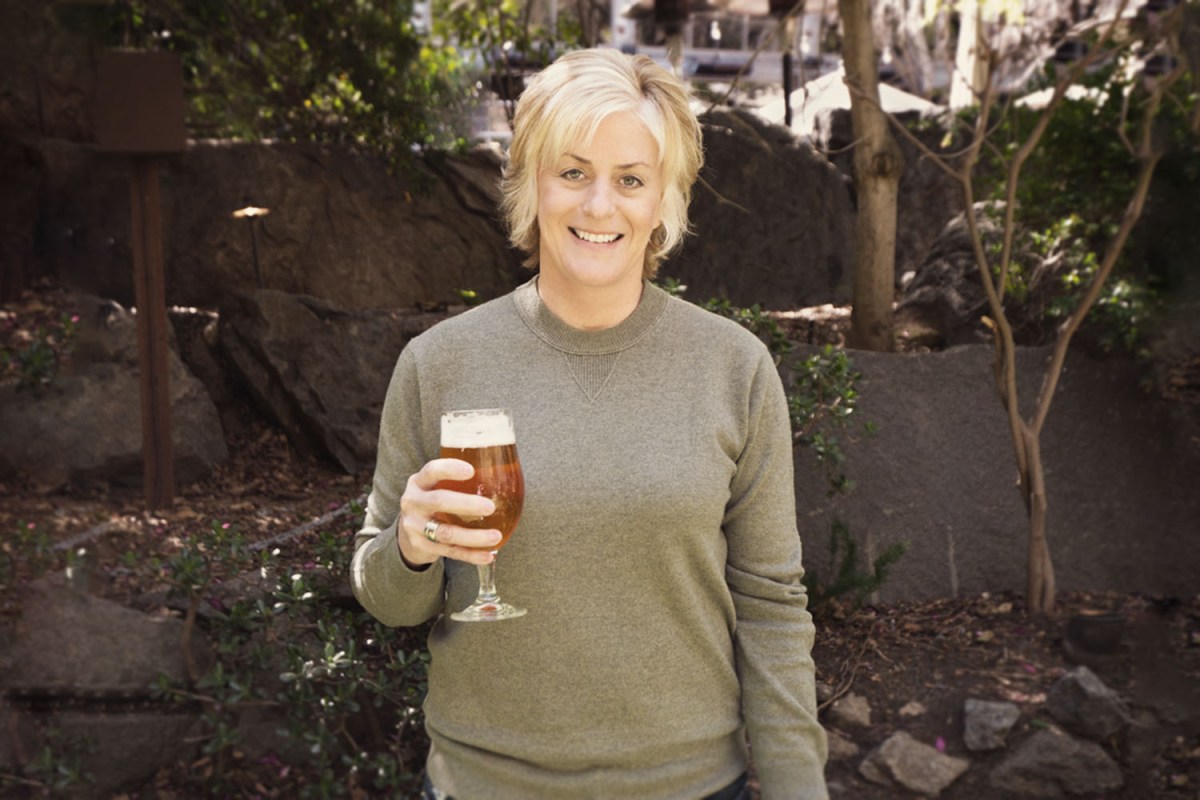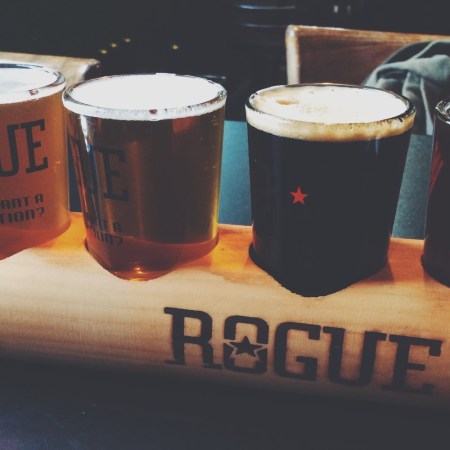If you know anything about craft beer, what likely first comes to mind when someone mentions San Diego’s Stone Brewing are bold, ultra-hoppy IPAs. Beers like Ruination, its Enjoy By series and even its flagship Stone IPA solidified the brand’s reputation as a West Coast IPA pioneer and served as its calling card for decades. But in recent years, Stone has shifted its focus a bit, broadening its horizons and introducing Buenaveza Salt & Lime Lager. The brewery even expanded beyond beer entirely and launched its Buenavida line of hard seltzers last year.
Those new ventures have been helmed by CEO Maria Stipp, who joined the company in 2020 after five years at Lagunitas Brewing Co. (Stipp also recently oversaw the brand’s $168 million sale to Japanese beer brand Sapporo, saying in a statement, “This unique partnership allows us to preserve the Stone legacy that our fans know and love and will add exponential opportunities for growth, from production to more investment in people, equipment, sales, and marketing.”)
We caught up with Stipp recently to chat about her future plans for the company, how the craft beer industry has been forced to adapt during the pandemic and why diversifying doesn’t just mean adding new styles to Stone’s portfolio. Check out the conversation below.
This interview has been edited and condensed for clarity.
InsideHook: Tell me a bit about your vision for Stone and what your goals are, what you hope to see in the coming years.
Maria Stipp: Well, so I think historically, Stone has been known for big, bold IPAs, Arrogant Bastard as an example. Probably more hop-forward flavors than perhaps other IPAs or beers that you choose from craft breweries. So we made a decision to sort of get some consumer feedback, and in the spirit of that, what we learned is that we were doing a really, really good job reaching the core of our consumer. Fans of Stone love Stone. But what we were lacking were people that were trying us for the first time and then converting, so the more top-of-funnel consumer where we’re bringing people into Stone, we were missing the boat. So we thought, “Well, how are we going to start attracting new fans?” And so that’s where our new mission statement has come from, and that is, “Stone will evolve and will become openly welcoming and innovating for the future while always celebrating amazing beer.”
It’s a nod to our core to say that we’re always gonna stand for amazing beer, but it’s also a recognition of the fact that we do need to evolve and start opening up our minds to how we attract our fans. And so that’s really where we’ve taken that step and gone full-on and made Buenaveza our number one priority for the last two years. It’s become our number one draft brand in that period of time, and our number three brand overall. It’s a Mexican lager, and that’s not typical for craft breweries, I think, to lead with a lager or to make that a priority. We’re in the most important Mexican import market in the world, and so that’s another really good thing for us in that we can be just north of the border as well. So, our tagline for it is, “Imported from San Diego.” What we’re thinking about is a non-IPA brand family around Live Buena. And it’s different than the Stone IPA or Arrogant Bastard, in that it’s lighter, it attracts new fans, and then we can add more brands under that umbrella to really grow our overall scope to new people. And so we’ve added Buenavida, which is our seltzer in a glass bottle. And then this summer, we’re going to be adding Buena Fiesta, which is a tequila-based canned margarita that we’ve worked on, so that we have a beer, we’ve got a seltzer, and we have an RTD underneath that Buena family, and they all sort of can work together to really make a point that we offer a lot of different things for different people.
You mentioned the hard seltzer. What was it like getting into that hard seltzer space? How do you draw consumers who maybe have only tried a White Claw and compete in that market?
The seltzer category has become a bit of sea of sameness, I think. With the slim cans, they all kind of look similar. I don’t necessarily know if people discern one versus the other when they’re going to buy them. It doesn’t appear that there’s a lot of loyalty in the category. So the glass bottle was our differentiator. And while it is, one would say, somewhat narrow in the spirit of how you can merchandise it or where you might be able to sell it, we’re fine with that because it creates a point of difference for us to be able to go in and sell it differently than perhaps our competitors. And also we took a really, really high bar in terms of quality. So our brewers, when we started talking about making a seltzer, had already been thinking about how they could do it within the breweries. And our base is super clean, so final product comes out incredibly high in terms of quality. So we know that we can be tasted beside others and taste better, and put it in a premium container like glass, so that we truly put a fine point on the fact that we’re working really hard to bring quality to the consumer.
What was it like navigating the pandemic when you first came on at Stone?
Well, in terms of me personally, I started in September of 2020, right in the throes of it. I thought I was starting toward the end because I underestimated how long it was gonna go. And so starting a new job and not being able to sit around people and get to know everyone was difficult for sure, but we found ways of getting to connect. But we also obviously have production staff, and we have our own distribution company where people are going into grocery stores and driving trucks every day, right? So we had to find ways of keeping our employees safe, and we took a really high bar of safety with our teams, so everything from equipment that they needed to allowing COVID time for situations that happen either at home or with friends or family. We just had to stay super flexible and constantly changing ’cause it evolved at least three times now through this whole process. We have a new normal we have to work through.
How do you think that the pandemic changed people’s drinking habits? When you were looking ahead at what you want to plan for and what sort of things you want to brew, was that something that you took into consideration?
Yeah. Well, partially where the notion of bringing an RTD to market has come from, right? So we taught people that they can have high quality drinks at home; that’s what we’ve done. And in the alcohol category, the booze category in particular has done really well through this whole thing, and tequila ranks really high on that, so it fits well with our brand family. So I think the RTDs were born out of the fact that people were drinking more at home. And now, I think the other thing that we’ve learned is that bars and restaurants are also learning how to serve out of cans rather than pay for expensive bartenders, which is another really interesting phenomenon, because they’ve had to put a lot more money against servers and kitchen staff because of wage increases, and so they’ve been able to find ways of serving drinks that are already pre-made. So that’s another change. And it’s still early to see, is that gonna stick? Are we gonna go all the way back to the fancy craft-made drinks with bartenders? It’s hard to know, right? I think we’re all still trying to figure it out.
Broadly speaking, what do you think the future holds for the craft beer industry? What do you think the big trends coming up are going to be?
So ever since I’ve been in craft, there’s been a similar theme, which is that the IPA category is always the winner. It is the largest piece of the pie, and it continues to grow. So thankfully, Stone has a very strong anchor in that IPA category, and then the other piece that was born was the hazy portion of the IPA category, which is on fire still, so that’s where we came with our hazy IPA. Spent a lot of time on that one as well, and innovated there. And we have a right to win in the IPA categories, which is great. So I think we’re gonna continue to see IPAs continue to grow and continue to do well. The thing that keeps me up at night, as I’m sure anyone in the craft beer space, is that, are we starting to lose those very early legal drinking age folks to other trends that may not be as strong within craft beer or beer at all? What does that mean for us, and how will we have to evolve even more to continue and attract new people? It’s gonna be very interesting to sit down with our brewers and say, “What’s next? Where do we wanna go next?” I think it’s probably lighter, brighter, maybe pale ales. Could be lower ABV, we need to start playing a bit more there. Lighter lagers, things like that, so that we can start to attract those new fans. So we’re gonna continue to press ourselves to try to come up with those innovations.
With low-ABV and non-alcoholic beer on the rise, what do you think the future is for a big, bold IPA?
I think that there are certain breweries and brands that are probably really well-suited to go into that NA space. I don’t know that Stone necessarily is, but I could say Imperial IPAs are still dominating the category. In fact, I believe the Voodoo Imperial is still the number one growth brand for [New Belgium Brewing]. So I think that there’s an interesting thing that’s happened where either people are choosing either non-alc or super low-ABV, or Imperials. People seem to be looking for an efficient beer in that higher-ABV category. Maybe they aren’t drinking as many as they were before. But we know how to make those. We’re good. [laughs] These aren’t mutually exclusive categories. So, people might enjoy a double IPA, and then shift to a non-alc and then go back in the course of one occasion. So it’s really about just what needs you have in that moment. So I don’t think the growth of lower ABV, non-ABV is necessarily at the risk of higher. I think it’s just having a portfolio that meets those very needs as much as we can.
What drew you to craft beer initially?
I worked for Miller Brewing Company a million years ago. I even then was not a huge lager and big beer person, so I didn’t drink much of it. When I left that industry, I went into technology for a long time. And then I found myself living in San Diego, California, and all of my hardware and software engineers had this routine where they would go surf in the morning, come into work around 10 o’clock in the morning with sand on their feet, and then work until like 5, and then 5:01 would happen, and they would go visit all of the craft breweries. And they started inviting me to come along, so I started to get to know the craft beer scene through those folks, and I started to really fall in love with it, because it didn’t taste like anything I’d ever had before.
And then I got the crazy luxury of getting a phone call to work at Lagunitas. Lagunitas was one of my favorite IPAs at the time, and I’m like, “Well, this is crazy, right?” So, I got lucky to get introduced to a really cool brewery like Lagunitas and now Stone, which is also wonderful and amazing. And I think for me, it was… I did not fully understand the scope of what those four ingredients could make. And it really wasn’t until I started getting curious about it and tasting different things that I realized that it isn’t like what you think beer is. And if you’re not a beer person, it’s kinda like neither was I, but try. I think that’s where trying things can really open up your world.
What do you think is the single biggest issue that the industry is going to have to face moving forward?
When I go to a party and there are 21, 22, 23-year-olds there, their view of craft beer is very different than mine. They did not start drinking craft beer at the time we did, where it was very new and novel. And this is their parents’ experience; it’s not their experience. That’s how old I am. And so watching their drinking patterns, it’s just extremely different, and I think it’s because the alcoholic beverage category has proliferated to so many different places. Old times was like wine was over in one section of the category of grocery, beer was in a different cold box and the spirits had a completely different section over in some other place, and so now everything sort of is merging together, you see products in the beer cold box that are made with agave, you see seltzers. What I see in grocery baskets is a combination of all of it, and there is not necessarily any badge of like, “I’m a craft beer drinker.” So we just have to come to terms to the fact that we may not have as much of that lifestyle approach that maybe we had before. It just means that we need to evolve on our own and become more important for those drinkers and get on their radar screen, and it’s just gonna take innovation, it’s gonna take focus in our marketing efforts and we’re gonna have to stay on our toes relative to what those evolving trends look like.
How do we diversify craft beer in terms of bringing on more women? What has it been like for you as a woman in such a male-dominated industry?
Yeah, so I’ve been in it now for seven years-ish. And it’s been a bit hard because a lot of brewers that I’ve hired are mostly men. You have to challenge your hiring managers that they need to come up with applicants that are female. And if you just start creating a habit inside of your hiring process that says, “Look, we need to find female applicants as well as male applicants, and I want them being interviewed at the same pace,” I think that’s part of what’s changing a bit. It’s becoming more mainstream to have more women in craft, and so I think that will snowball. But I think it’s probably most alcoholic beverage companies are dealing with the same phenomenon. At least, that’s what I’m hearing. And we can all do a better job. So Stone has created a Women of Stone network, which is an internal opportunity for any women within the company to have a forum, not only to just share best practices but also to air out anything that needs to be addressed or concerned or actually even to raise their hand and say, “I’d like to have a mentor, or I’d like to be coached in a certain area,” and we take live notes on that, so that we can continue to refine our approach and make the environment for women at Stone the best we can make it.
It’s been just evolving at Stone where, not so long ago before I started, we would innovate and then we would have a panel of experts where they would taste it and they would give their notes and then we try to refine recipes, but they were all men. And now, it’s not all men. And we certainly have a different take on what might be something that we should do or why maybe it tastes a certain way. And I think that’s super important, just like it is for branding and packaging and really having a nod to the fact that this should be for everyone. How do we make sure that that occurs?
Every Thursday, our resident experts see to it that you’re up to date on the latest from the world of drinks. Trend reports, bottle reviews, cocktail recipes and more. Sign up for THE SPILL now.























